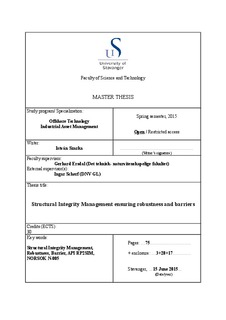| dc.description.abstract | Offshore structures operate for decades in harsh environment. They are exposed to extreme environmental loads and degradation effects. Changes in configuration, weights and operational condition represent also a challenge. Lost knowledge and experience over time due to personnel leaving companies, unregistered or unmitigated changes, suboptimal inspection procedures and schedules may affect cost effective and safe operation.
Structural Integrity Management (SIM) is the process to ensure compliance with regulatory and company requirements over time, and thus ensure the structure is fit-for-purpose until decommissioning or removal. The SIM process involves systematic filing of all important historical information for later easy retrieval. This information relates to fabrication, structural assessments, inspection findings, modification or life-extension projects. It also forms a framework for scheduled and unscheduled inspections.
Barriers are used in the risk analysis and risk management regimes of socio-technical systems in order to help tackling the problems and diversities connected to accidents in a systematic way. Barriers are intentionally planned functions to prevent, control or mitigate the propagation of a hazardous event from making harm or reach its full consequences. It is common to have a series of barriers, each implementing a particular function, the serial sum of which is intended to cover all the foreseeable failure scenarios connected to the hazard.
Robustness is desirable property in structures and systems. Robustness is the quality that defines how structures behave outside their operational envelope and their potential to survive accidents. From a strictly structural point of view, robustness mitigates the susceptibility of progressive collapse, i.e. no damage disproportionate to the initial failure should occur. If robustness is defined with the use of barriers, it means such a layered defense system that is aimed to prevent initial damage and to hinder hazards from propagation, hence limit the consequences on humans, the environment and assets.
In the thesis it is shown that the purpose of SIM – ensuring suitability and safety – requires the SIM standards to incorporate and put emphasis on robustness and barriers.
SIMS, the software product of DNV GL is also presented in the thesis. SIMS is a supporting tool for Structural Integrity Management processes that was created to be a change management database. SIMS integrates the Survey changes, Assess changes, Find information and Ensure integrity functions. SIMS is able to handle a large portfolio of platforms in a resource effective way, with adequate care to information security. The aim of SIMS is integrity assurance which is achieved by barrier control with full compliance to NORSOK standards.
To demonstrate numerical calculations in connection with structural robustness, a member consequence calculation of an offshore bridge with truss girders is performed. | nb_NO |

